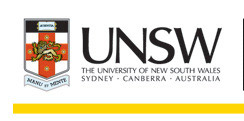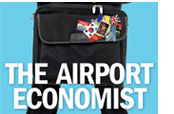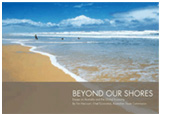Colombia’s Premium blend
By Tim Harcourt*
There’s been a lot of research around now about the economics of country ‘brands’ and how they affect a consumer citizen’s perception of a country in the same way they may view a consumer brand like Apple, Coca Cola or Qantas. Simon Anholt, one of the most famous brand ‘gurus’ and many of his colleagues have been engaged by different countries’ trade and tourism boards to shape how the rest of the world. Even the Australian Government got in on the act with their ‘Australia Unlimited’ campaign. The research, they say, is very important as we only think about other countries for a brief moment of time in our lives. And unless they are a superpower or a close neighbour (and sometimes more of an enemy than friend hence the importance of paying attention to them) we spend very little time thinking about other places at all. It was brought home to me at the APEC Leader’s Summit in Sydney in 2007, when all the APEC heads of government gathered in the harbor city. The Russian President Vladimir Putin, who was the first ever Russian head of state to visit our shores, was asked “What do you think of Australia?” and he replied: “I never think of Australia.” And in some ways we shouldn’t be surprised by Putin’s remarks, as it’s not possible to go everywhere in one life time (even if you are an airport economist!) let alone think about every place in depth. At the end of the day, we have a brief impression or perception of most countries, and they are just the ones we’ve heard of. That’s we’re the country brand research plays an important role.
And for those who say that a country’s ‘brand’ doesn’t matter, they should look at the case of Colombia. For years the country’s image was dogged by images of cocaine wars and drug cartels. The high point (or rather low point) of Colombia’s poor image took place during the 1994 FIFA World Cup in the USA, when one of Colombia’s players, Andres Escobar was gunned down by drug lords after scoring an own goal and putting the highly fancied national team out of the finals.
But on an airport economist tour of Colombia perception could not have been so different than reality. On arriving in Bogota international, I exchanged friendly comments with the immigration official in both Spanish and English, who asked me “How Lleyton Hewett was going”, and the conferences around Bogota were enthusiastic and lively with leading business people and government officials having a positive view of Australia’s economic capability and a keenness to engage in Pacific rim institutions (such as APEC) where Australia has a good reputation with strong multilateralist credentials. Sandra Salamanca Rosa, the Director of Colombia’s National Business Association (ANDI) who hosted me in Bogota explained: “Australia is an emerging investor in Colombia’s resources sector, with major players like BHP-Xstrata, Ludowici Range, Cerromatso (BHP’s Nickel Division), Sedgeman and Downer EDI all playing a major role in Bogota along with Orica, Qantas and QBE.” Salamanca Rosa, speaks fluent Mandarin and her savvy business and language skills were on display as she showed leading Australian business delegates around Cartagena, on the Caribbean coast of the country, at a major oil and gas investment conference.
But it was really in Medellin, where you could see the new Colombia in action. Medellin in the centre of Colombia and was the centre of the drug wars. Medellin has a very young population and a large reserves of human capital, with a highly education, service orientated professional workforce. On a helicopter ride around Medellin and the surrounding historical town of Santa Fe, the 35 year old head of the state department of Productivity and Competition, (in the state of Antioquia) Maximilliano Valderrama, explained: “Colombia’s main resource is our people. Given the past and its impact on our national image, we have to work twice as hard as everybody else to show what we can do. Many Colombians do MBA and other higher degrees in Australia, USA and Europe but they all want to come back to Colombia to build a new society.”
Valderrama’s observations are supported by empirical research by Maria Beamond, a Colombian born Brisbane based researcher who looks at human capital migration between Latin America and Australia. Beamond says: “there is a preference that the preference for Latin American graduates, including Colombians, after finishing their studies, is to work for one to two years initially in Australia, preferably with a company with business operations in their home country in the hope of subsequently being transferred to the company’s office in their home country. “
In fact, symbolically, Medellin was the home town of Andres Escobar. I was taken to his home club where he was a feted local hero. Valderrama, explained: “we have created a major sports and recreation complex in this area. During the days of the drug wars, kids were scared to get out of their house, now they can put that energy into sport. And after what happened to Andres, we wanted to honour his memory giving his people a chance to play football, run, swim, and engage in outdoor pursuits whilst they finish school.”
In fact, education is a big part of Colombia’s relationship with Australia, along with mining and professional services. There are now around 10,000 Colombian students in Australia which makes it the second most important source of students from South America after Brazil. And UNSW has a fare share of those bright young Colombians. I noticed it after getting back from Colombia on campus at UNSW but more what made me think about it was that famous Colombian service culture that Maximilliano Valderrama talked about. You see it in the shops of Bondi junction and Sydney’s eastern suburbs as many Colombian students at UNSW work part time in the local retail industry.
As Maria Beamond points out, “from the beginning of 2000, Australia became popular as a
destination to study as Colombia was confronting an economic and political crisis so therefore, professionals that were retrenched from their companies and wealthy parents decide to invest in higher education in Australia. Colombians are resilient because people have had to experience hard security circumstances that have made them to be tough
and spirited. It has made that Colombians help to bridge the gap between both countries as demonstrating to be good performers at work, and easy adapt to new work environments. Most of us, the professional Colombian cluster; know that we are the ambassadors of our country in Australia, in order to change the perception of Colombia in this country, which is also our home.”
Australia’s new interest in Colombia has been crystallized by the appointment of experienced diplomat Crispin Conroy to a new Austrade office in Bogota. Conroy sees Colombia was one of the new emerging markets in Latin America that is ripe for Australian investment. Conroy emphasised that whilst “the security issue is not resolved but it has changed significantly and the Australian brand’s strength in Latin America is at its highest in emerging markets like Colombia and Peru, just as it has been in Chile.”
So whilst we may have been thinking about Colombia for the wrong reasons a few years back, the new opportunities may enable Australia’s to think about Colombia in a different way in future. When it comes to country branding, perception matters as well as reality, and a new generation of Colombians (many of whom will be Australian educated) have a chance to put it right on the world stage.
*Tim Harcourt is the JW Nevile Fellow in Economics and an adjunct professor in International Business Strategy for Asia and South America at the Australian School of Business at the University of New South Wales (UNSW) in Sydney. He is also the author of The Airport Economist www.timharcourt.com.
Tim would like to thank the Council of Australian-Latin American Relations (COALAR), the Department of Foreign Affairs and Trade (DFAT), Austrade and the Government of Colombia for assistance with his visit to Colombia. Australia Latin America Business Council (ALABAC) is leading a mission to Colombia in September.













No Comments so far ↓
Comments are closed.